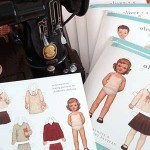How to trace patterns
-
16 years ago LINK
 enajybbil
@enajybbil
enajybbil
@enajybbil
If I’m using a pattern that is for the 6 month size how do I get the marks on the fabric for cutting it out? Obviously I’m not going to cut away every other size, right? I’ve been using a barbaric method so far that nearly always ends in cussing. What’s the real way to do this? I seem to remember something about transfer paper and a little wheelie thing. Where might I get those?
16 years ago LINK April Henry
@April1930s
April Henry
@April1930s
Yes, you can use transfer paper and a tracing wheel. JoAnn’s carries them or Wal-Mart might even have them. They’re pretty inexpensive, but you’ll use them a lot. Just be careful about the surface you’re applying pressure to because it can mar a wood finish. I like to do all my cutting/transferring on an Olfa cutting mat.
The spiked wheel can sometimes be used without tracing/transfer paper depending on how soon you’re going to cut and how ‘spikey’ the wheel actually is – some of the vintage ones look deadly, but they were designed for this purpose – to make temporary but visible marks in the fabric. But, if you’re going to have significant amounts of time in between marking and actually cutting, then transfer paper is best so you can remember where you made your marks.
16 years ago LINK enajybbil
@enajybbil
enajybbil
@enajybbil
So you’re saying that the tracing wheel leaves actual indents (?) in the fabric? I’ve looked around for transfer paper but can only find 8 by 10 inch size and that’s fiddly to deal with what with pins and all….I remember the quilting/sewing teacher in high school having way bigger papers.
16 years ago LINK enajybbil
@enajybbil
enajybbil
@enajybbil
P.S. don’t the spiky wheels rip through the pattern paper?
16 years ago LINK April Henry
@April1930s
April Henry
@April1930s
Yes, the spiked wheels can leave marks through the pattern paper, but thankfully, the Oliver + S patterns have a heavier weighted paper so they withstand quite well – CONSIDERABLY better than regular tissue patterns. I know I’ve seen tracing paper that’s about 10 inches wide, but it folds out to be 20 inches or so…. I’m always stockpiling the old packets whenever I see it at thrift stores or tag sales.
OH, and yes, the ultra-spiked wheels do leave visible indents which make cutting a breeze.
15 years ago LINKjodier @jodier
I use the glass door method (LOL) Tape the pattern to the sliding glass door on a bright day. Tape some other paper over the top and just trace the lines – they all show clearly with the light behind. Then just cut them out along the lines and pin to your fabric. You can keep using the same pattern trace until you need to move to the next size.
I use pattern tracing paper that I get at my cheap super fabric store (Spotlight in Australia and I assume Joann’s in the US). But have also used newspaper if I am using dark fabric because the print comes off and marks light stuff. But the colour glossy catalogues make excellent patterns once you tape a few pages together. They are also a bit thicker which makes cutting around them easy although pinning is a pain. I use the “weight the piece down with canned tomatoes” method and either cut around with a rotary cutter or else just trace around the shape with a permanent sharpie marker and then cut with scissors. You don’t need to worry about the permanent pen marks for tracing the shapes onto the fabric because they are either lost in the cutting process or in the seam allowances.
For the pivot parks and darts, I hand sew using doubled thread through the pattern and then through the fabric and then back again (single running stich). Cut off the thread leaving 3 inches of tail on both the starting and stopping ends and lift off the pattern pulling all the tails through as you do. Then separate the two pieces of fabric gently sliding the top one along the thread tails until there is about an inch between the pieces and then snip the threads half way between. This leaves one piece with a single running stich and some hanging ends and the other pierced by two threads with an inch or so tail either side.
15 years ago LINKteambernard99 @teambernard99
I think it is called Pattern Ease at the fabric store. It looks like interfacing, but a little heavier. It is 50 inches wide so you can get a lot out of it!!
15 years ago LINKRoslynweatherall@yahoo.com @Roslynweatherall@yahoo.com
I use something called Hera Maker 490 by Clover. Pin or weigh down the fabric then just fallow the lines, pressing firmly. It will leave a nice line / crease on the fabric. Noting to erase or extra things to buy. Sometimes the print on the fabric can make it more difficult to see, so in those situations I just mark with a standard fabric marking tool (stabilo?)
I have gone over the cheaper pattern papers 7 maybe 8 times before any tearing from use.
15 years ago LINKteambernard99 @teambernard99
With the pattern ease I lay the pattern out and trace it. I cut out the pattern ease and lay it out to cut the pattern then. The pattern ease only costs about $1.50/yard at local stores. I don’t cut the pattern out that comes from Oliver + S…I keep it intact. I have three girls to sew for, so I need to keep the patterns.
15 years ago LINKAnonymous @
I always trace my patterns onto Reynolds freezer paper. You can get a roll at your grocery store for about $2. I get several patterns out of a roll and it is a lot sturdier than most tracing papers. If I need a wider piece than the roll allows, I just tape 2 pieces together with masking tape (because you can write with a pencil on masking tape). I have never had a problem seeing the markings through the paper on Oliver and S patterns, but on some other patterns if you put another piece of white paper under the pattern it makes it a lot easier to see the lines and markings. This may be an over simplified way to trace patterns but it has always worked well for me!
15 years ago LINKAnonymous @
I also use the Pattern Ease material. I never cut my original patterns. Love keeping them intact so that I can make other sizes and/or pass the patterns along to someone else when my kids have outgrown them.
15 years ago LINKAnonymous @
Roslynweatherall@yahoo.com: Can you explain a little more about how the Hera Marker works? I don’t understand how the dents would stay in the fabric. Can you really see to cut out the pieces? Do you go back over the dents with a soluble marker for the markings that stay on the pieces as you sew? Or do you just use it to cut out the piece and do something else for the markings? I may just have to try to understand it. Thanks!
15 years ago LINKsewinginthecity @sewinginthecity
If you know you will be using the pattern size more than once, and this being Oliver and S, you probably will, I think it’s easiest to just go to the copy store. If a piece is bigger than 11×17, I tape sheets together. You can cut them out at home and have that size ready, and on a sturdy paper. For the next size, you can go back and copy the original again.
15 years ago LINK Nicole
@motherof5
Nicole
@motherof5
I know it can be time consuming , however, if you are going to use your patterns more than once, I would strongly advise drafting them onto a interfacing type fabric. I purchase mine from Spotlight (Aus) , it is about $1.50 /m, and it is very good to work with.
15 years ago LINKAnonymous @
I think you can use tracing papers.
You must be logged in to reply to this topic.
copyright
Unless otherwise credited, all work on this blog is © Liesl + Co., Inc, 2008-2026. You are welcome to link to this blog, but please ask permission before using any text or images.